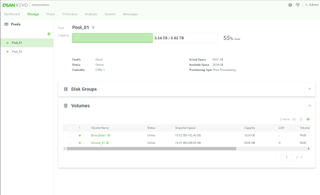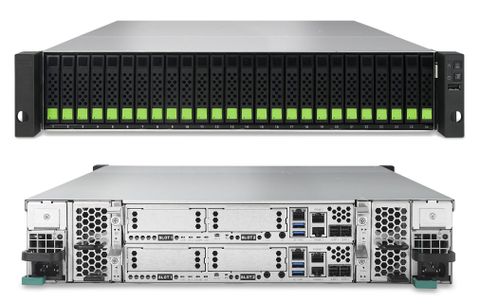IT Pro Verdict
Priced right for budget-conscious SMBs, Qsan’s XF2026D teams up enterprise-class storage features and fault tolerance with great all-Flash performance
Pros
- +
Good value; Great FC performance; Slick XEVO OS; High port expansion potential; QSLife app
Cons
- -
Expansion Slot 2 has 20Gbits/sec bandwidth limit
Storage specialist Qsan has a reputation for delivering affordable SAN solutions and now makes its play for the SMB all-Flash array (AFA) market sector. The XCubeFAS XF2026D is its first dedicated AFA offering and delivers an impressive range of features and performance at a price SMBs will find very appealing.
The chassis supports up to 26 SFF drives - two more than many competing 2U arrays. Along with dual hot-plug PSUs and fans, the chassis includes dual controllers running in active/active mode offering fully transparent failover.
This isn't Qsan's first AFA; it employs an almost identical hardware package to the XCubeSAN XS3226D which was introduced two years ago. What makes the XF2026D different is its XEVO OS and HTML5 web interface, which Qsan built from the ground up specifically for AFA applications.
Qsan XCubeFAS XF2026D review: Controller construction
The controllers are each powered by a quad-core Xeon D-1500 processor partnered by 32GB of DDR4 cache memory field upgradeable to 64GB. Cache protection is nicely covered as the small expansion slots above each PSU house a cache-to-flash module on one side and a battery backup module on the other.

Along with dual 10GBase-T iSCSI data ports, each controller accepts two expansion cards with quad-port 16Gb/sec FC and 10GbE SFP+ plus dual-port 16Gb/sec FC and 10GbE copper options available. Note that the second expansion slot on each controller has a maximum bandwidth of 20Gbits/sec so may restrict performance if quad-port cards are installed in it.
Expansion potential looks good and the controllers also have dual embedded 12Gb/sec mini-SAS ports. Using Qsan's 26-bay XD5326D disk shelves, you can daisy-chain up to 4 of them over dual-redundant links for a maximum of 130 SSDs.
Qsan XCubeFAS XF2026D review: Qsan XEVO
Deployment in the lab was swift. Qsan's QFinder app discovered the array and provided direct access to the XEVO web interface. Even a quick glance at XEVO impresses as its interface is totally different to Qsan's standard SANOS 4 software and, dare we say, much better designed.
The console opens with an informative status screen showing installed SSDs, storage usage, an overview of arrays, pools, volumes and hosts plus bold real-time graphs for overall latency, IOPS and throughput. We used eight Seagate Nytro SAS3 SSDs and moved to the interface's Storage page where we quickly created two four-drive RAID10 storage pools and let the wizard create one volume in each pool.
For performance testing, we used two Xeon Scalable servers running Windows Server 2016 and installed ATTO Celerity quad-port 16Gb/sec FC HBAs in each one. Host mapping is a doddle and all HBA WWNs were auto-discovered on connection to the array, allowing us to quickly map each server to a dedicated volume.

One noteworthy feature is the controllers operate in synchronous mode and not the more-common ALUA (asymmetric logical unit access). The bottom line is you can connect your hosts across both controllers for redundancy but, unlike ALUA, all MPIO links are optimized with none sitting idle in standby.
Qsan XCubeFAS XF2026D review: FC performance
With both our servers connected to the Slot 1 modules over quad-port 64Gbits/sec FC MPIO links, we watched the XF2026D deliver an impressive performance. To get a baseline, we ran Iometer on one server which reported 49Gbits/sec and 37.2Gbits/sec for sequential read and write rates and 49.1Gbits/sec and 47.3Gbits/sec for random operations.
Changing to 4KB blocks returned 370,000 and 215,000 IOPS for sequential reads and writes falling to 364,000 and 150,000 IOPS for random operations. With both servers running Iometer, we recorded a cumulative 97.6Gbits/sec and 70.3Gbits/sec for sequential reads and writes with random operations returning 97.7Gbits/sec and 53.2Gbits/sec.
General throughput is excellent with Iometer reporting a cumulative 691,500 and 429,500 IOPS for sequential reads and writes while swapping to random operations saw these settle at 686,700 and 301,000 IOPS. Latency is impressively low as we saw Iometer record no more 0.5ms for all our IOPS tests.
The only number we can't report on is controller CPU utilization, as the XEVO console doesn't have an option to display this. Furthermore, Slot 2 does, indeed, introduce bandwidth limitation as swapping the FC modules across from Slot 1 and rerunning a throughput test on one server saw around 220,000 IOPS for sequential reads.
Qsan XCubeFAS XF2026D review: Data protection and SSD monitoring
XEVO's protection groups streamline data protection operations as you can place multiple volumes in them and apply one set of schedules to control snapshots plus remote replication to an external array and local replication to another storage pool. Snapshots can be run on selected days as often as every 15 minutes while replication tasks can have one of eight traffic shaping groups applied to enforce bandwidth restrictions during peak and off-peak periods.

Data recovery is just as quick; just load the Snapshot Center by clicking on the gear wheel icon next to a volume in the protection group. This loads a list of snapshots where you apply the one you want to revert to or expose it as a new LUN for manual file and folder recovery.
Another smart feature of XEVO is QSLife. Accessed from the same console, this provides precise data on the remaining life of each SSD, presents usage graphs for each one and has three alert levels so you're never caught out when an SSD reaches the end of its working life.
Qsan XCubeFAS XF2026D review: Verdict
During testing we found the XCubeFAS XF2026D capable of delivering top speeds and IOPS over FC, although the lower bandwidth of the controller's second expansion slot may impact on overall performance. Nevertheless, it offers an impressive range of storage features for the price, the XEVO OS is a pleasure to use while its active/active architecture and six 9s reliability make this AFA a great choice for hosting mission-critical storage.
Verdict
Priced right for budget-conscious SMBs, Qsan’s XF2026D teams up enterprise-class storage features and fault tolerance with great all-Flash performance
Chassis: 2U rack
Storage: 26 x SAS3 SFF hot-swap drive bays
Power: 2 x 770W hot-plug PSUs
Cooling: 2 x hot-plug fan modules
Other: Cache-to-Flash and battery backup modules
Two hot-plug controllers each with the following:
CPU: Quad-core Intel Xeon D-1500
Memory: 32GB DDR4 cache (max 64GB)
Array support: RAID0, 1, 0+1, 3, 5, 6, 10, 30, 50, 60, N-way mirror
Ports: Gigabit management, 2 x 10GBase-T data ports
Expansion: 2 x host card slots, 2 x 12Gbps mini-SAS (SFF-8644)
Management: Web browser
Dave is an IT consultant and freelance journalist specialising in hands-on reviews of computer networking products covering all market sectors from small businesses to enterprises. Founder of Binary Testing Ltd – the UK’s premier independent network testing laboratory - Dave has over 45 years of experience in the IT industry.
Dave has produced many thousands of in-depth business networking product reviews from his lab which have been reproduced globally. Writing for ITPro and its sister title, PC Pro, he covers all areas of business IT infrastructure, including servers, storage, network security, data protection, cloud, infrastructure and services.



